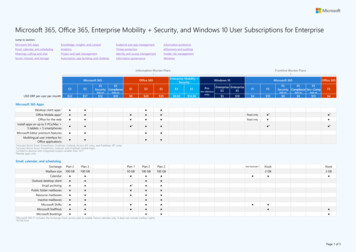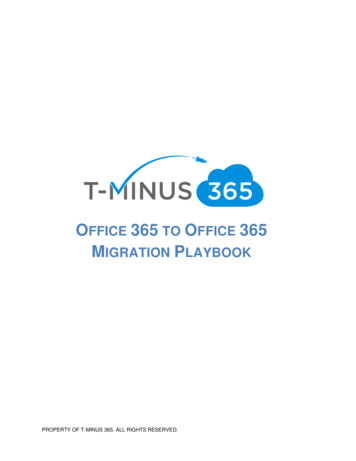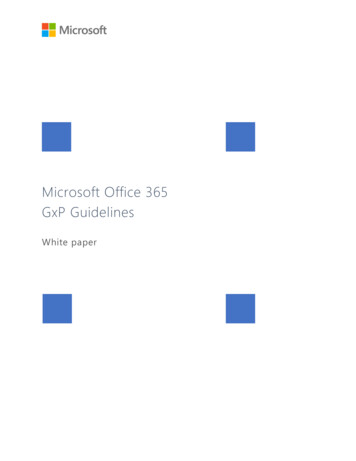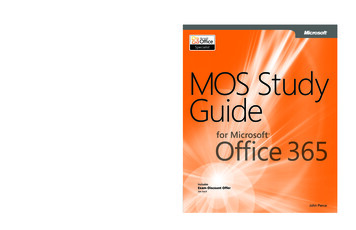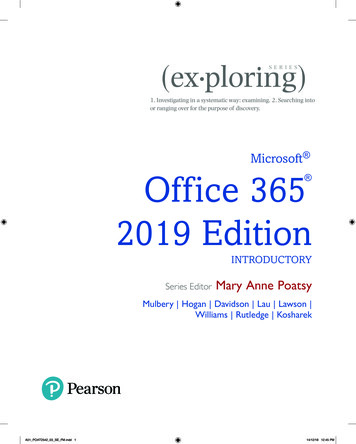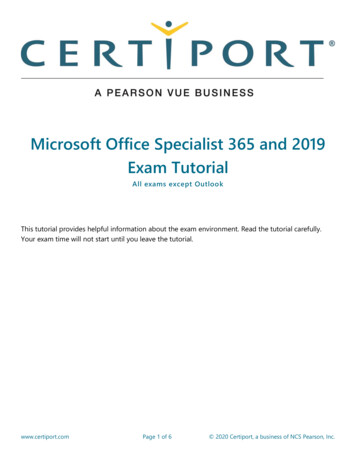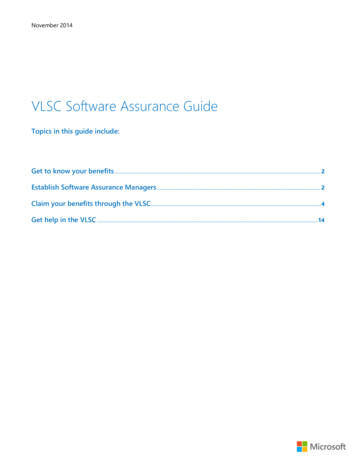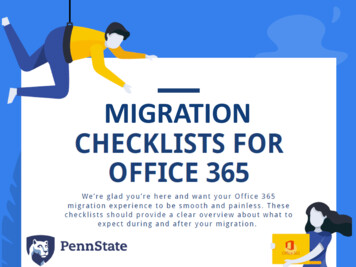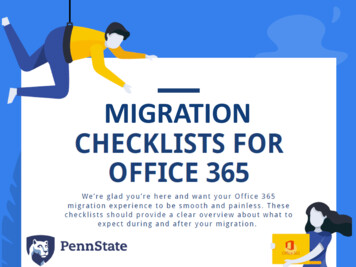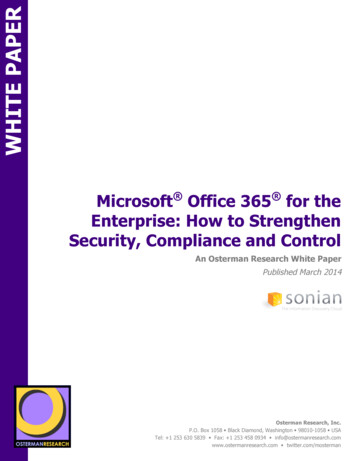
Transcription
WHITE PAPERMicrosoft Office 365 for theEnterprise: How to StrengthenSecurity, Compliance and ControlONAn Osterman Research White PaperPublished March 2014sponsored bySPONsponsored bysponsored byOsterman Research, Inc.P.O. Box 1058 Black Diamond, Washington 98010-1058 USATel: 1 253 630 5839 Fax: 1 253 458 0934 info@ostermanresearch.comwww.ostermanresearch.com twitter.com/mosterman
Microsoft Office 365 for theEnterprise: How to StrengthenSecurity, Compliance andControlEXECUTIVE SUMMARYMicrosoft Office 365 is a robust set of email and collaboration tools that is offered in anumber of configurations with varying levels of features and functions. Office 365represents Microsoft’s latest – and arguably, most successful – venture into the cloudservices space in the 13 years that the company has offered hosted services.KEY TAKEAWAYDespite the range of functionality offered in Office 365, like any cloud-based offeringit cannot be all things to all customers. There are some missing features in Office 365that will prompt some customers to consider the use of third-party, cloud-based oron-premises tools to enhance Office 365’s native capabilities. Specifically, we believethat these third party enhancements will be focused primarily on the security,archiving and encryption capabilities available with Office 365. That is not to say thatMicrosoft has not addressed these capabilities, but many third parties provide moregranular or more capable services than Microsoft has offered in Office 365. OstermanResearch believes that the third-party market for cloud-based and on-premisescapabilities designed to supplement or replace specific Office 365 features andfunctions will grow at a healthy pace along with the market for Office 365.AN IMPORTANT NOTEThe purpose of this white paper is not to dismiss Office 365, its features andfunctions, or Microsoft itself. On the contrary, we believe that Office 365 provides auseful set of features and functions that will be well received by many organizations.However, our goal is to be as fair and balanced as possible in discussing both theadvantages and disadvantages of Office 365. As with any cloud-based service, thereare limitations in Office 365 that can be managed more appropriately through the useof third party services. Any limitations discussed here are not limited to Office 365,but can be said for any cloud-based solution.Office 365representsMicrosoft’snewest foray (inquite a long lineof them) into thecloud-basedemail andcollaborationspace.ABOUT THIS WHITE PAPERThis white paper discusses the Office 365 environment, its applicability fororganizations of all sizes, and the third party capabilities that Office 365 customersshould consider to supplement the platform. This document also provides a briefoverview of its sponsor – Sonian – and the company’s relevant offerings.KEY FEATURES AND FUNCTIONS OF OFFICE 365Office 365 represents Microsoft’s newest foray (in quite a long line of them) into thecloud-based email and collaboration space. The platform is a group of cloud-basedofferings that includes Exchange Online (most accounts offer 50-gigabyte mailboxes),SharePoint Online, Lync Online, and desktop and Web-based versions of Microsoft’sproductivity applications. The various components and offerings in Office 365 areshown in Figure 1.Figure 1Versions and Costs for Office 365 (US pricing)VersionOffice 365 SmallBusinessOffice 365 SmallBusiness PremiumOffice 365 MidsizeBusinessExchange Online Plan 1 2014 Osterman Research, Inc.IncludesEmail, online conferencing, public Website, file share, Office Web appsSame as above plus desktop versions ofall Office applicationsSame as above plus Active DirectoryintegrationEmail, Active Directory integration /User/Month 5.00 12.50 15.00 4.001
Microsoft Office 365 for theEnterprise: How to StrengthenSecurity, Compliance andControlFigure 1 (concluded)Versions and Costs for Office 365 (US pricing)VersionOffice 365 Enterprise E1Office 365 Enterprise E3Office 365 Enterprise E4IncludesSame as above plus file sharing, onlineconferencing, enterprise social, OfficeWeb appsSame as above plus desktop versions ofall Office applications, eDiscovery CenterSame as above plus Yammer Enterprise,other features /User/Month 8.00 20.00 22.00Source: MicrosoftOrganizations are migrating to Office 365 because of its advantages, which generallyapply to cloud-based email and collaboration systems: Lower and more predictable costs of ownership Faster deployment of new services The ability to upgrade or downgrade capabilities quickly and easily The ability to free IT staff for other tasks The ability to add new capabilities that would require either the addition of newstaff members or access to expertise that is not readily available internallyMostorganizationsplan to migratesome or all oftheir users toOffice 365 in thenear- to midterm.GROWING USE OF OFFICE 365Office 365 growth has been quite robust: Microsoft reached one million Office 365 Home Premium subscribers in May2013i, two million by October 2013ii and 3.5 million by early 2014iii. Microsoft claims that more than one million US government employees use Office365iv. Microsoft estimates that more than 15% of its Exchange installed base is nowusing Office 365v. In 2014/Q2, Microsoft reported that it more than doubled its commercial cloudservices revenuevi.As shown in Figure 2, the Osterman Research survey conducted for this white paperfound that most organizations plan to migrate some or all of their users to Office 365in the near- to mid-term. 2014 Osterman Research, Inc.2
Microsoft Office 365 for theEnterprise: How to StrengthenSecurity, Compliance andControlFigure 2Organization’s Plans for Migrating to Office 365Among organizations that are considering a migration to Office 365Source: Osterman Research, Inc.Microsoft hasmade Office 365compliant with anumber ofimportantstandards andotherrequirements asverified byvarious thirdparties.OFFICE 365 CAN BE USED IN REGULATED ENVIRONMENTSAlthough Microsoft has been providing cloud-based email for a number of years, thecurrent versions of their cloud offerings are quite robust and offer a number ofenterprise-grade features and functions. In addition, Microsoft has made Office 365compliant with a number of important standards and other requirements as verifiedby various third partiesvii, further enhancing its potential for use by enterprisecustomers: The Federal Information Security Management Act (FISMA) Business Associate Agreements under the Health Insurance Portability andAccountability Act (HIPAA) The Gramm-Leach-Bliley Act (GLBA) The Family Educational Rights and Privacy Act (FERPA) Title 21 CFR Part 11 of the Code of Federal Regulations The Federal Information Processing Standard (FIPS) 140-2 Trusted Internet Connections (TIC) International Organization for Standardization (ISO) 27001 European Union (EU) Safe Harbor and Data Protection Directive Model ClausesThe result is that Office 365 may be used in regulated environments, such ashealthcare, government and also in the European Union. Microsoft also benefits fromsupport for a hybrid model given that it has a commanding market share for desktopproductivity applications and its dominance in the business email market throughExchange. This gives Microsoft an advantage that many competitors cannot enjoy. 2014 Osterman Research, Inc.3
Microsoft Office 365 for theEnterprise: How to StrengthenSecurity, Compliance andControlWHAT ARE THE DRAWBACKS OF OFFICE 365?Although there are a number of advantages associated with using Office 365, thereare some limitations about which decision makers should be aware:ARCHIVING LIMITATIONS Migration to Office 365 has been problematic for some organizations, particularlythose that want to maintain a hybrid deployment of on-premises and cloudbased users. Microsoft’s In-Place Archive (formerly known as the Personal Archive) is asecondary mailbox that can be deployed on the same or a different server from auser’s primary mailbox. The In-Place Archive or retention policies require eitheran Exchange Server account or an Exchange Online account together with anExchange Server Enterprise Client Access License and only certain Outlooklicenses. In addition, some Outlook versions are not supportedviii. The archiving functionality in Office 365 has some additional limitations,including lack of support for Exchange Online archiving with Outlook 2011 underMac OS Xix, as well as lack of support for accessing archived emails via Androidand iPhone devices. According to Microsoft, “You can't designate an Office 365 mailbox as ajournaling mailbox for on-premises mailboxes. If you’re running a hybriddeployment with your mailboxes split between on-premises servers and Office365, you can designate an on-premises mailbox as the journaling mailbox foryour Office 365 and on-premises mailboxes.”x Some versions of Office 365 do not archive instant messaging content,conference content, or content from application-sharing or desktop-sharingsessionsxi. Some versions of standalone Lync Online plans do not provide instantmessage and file filtering, instant message content archiving, or conferencecontent archivingxii. SharePoint Online offers eDiscovery, compliance with various regulatoryobligations and other capabilities, but it does not archive content. Because of thegrowing proportion of content that is stored in SharePoint within theorganizations that have deployed it, the ability to archive SharePoint content isessential. End user search capabilities in some versions of Office 365 are somewhat morelimited than they are with many competing cloud-based and on-premisesarchiving solutions. Office 365 includes no native surveillance features that allow monitoring orsampling of communications. This is an important capability for highly regulatedfirms, such as broker-dealers that must sample communications per FINRARegulatory Notice 07-59xiii. For organizations that need to journal content into Office 365 – such asSalesforce Chatter content, instant media, social posts, etc. – a third partyarchiving solution will be required, since journaling within Office 365 does notsupport import of external, non-Lync content.Migration toOffice 365 hasbeen problematicfor someorganizations,particularly thosethat want tomaintain ahybriddeployment.RETENTION LIMITATIONS Only Office 365 Plans E3 and E4 include the ability to search across Exchangemailboxes and SharePoint sites, Information Rights Management, archiving,litigation hold capabilities and unlimited storagexiv. The maximum size of the arbitration mailbox is ten gigabytesxv. 2014 Osterman Research, Inc.4
Microsoft Office 365 for theEnterprise: How to StrengthenSecurity, Compliance andControlItems in the Office 365 Deleted Items and Junk E-Mail folders can be retained fora maximum of 30 daysxvi.DATA LOCATION LIMITATIONS Microsoft stores Office 365 customer data in a number of different countriesbased on the location of the customerxvii. Moreover, Microsoft can movecustomer data without notice and will not guarantee exactly where a customer’sdata will be stored. For example:oGovernment customers in the United States: primary data and backupcenters are located in the United States.oNorth American customers: primary data centers are located in the UnitedStates.oMost EMEA customers: primary data centers for Office 365 are in Irelandand the Netherlands; Lync Online customers provisioned before October2011 may be hosted from a US data center.oAsia Pacific customers: the primary data centers for Office 365 data are inSingapore and Hong Kong, but a data center in Ireland is used for ActiveDirectory and Global Address Book data. Lync Online and Online Portal dataare served from a US data center.oSouth American customers (except Brazil): primary data centers are locatedin the United States.oBrazilian customers: the primary data center for SharePoint Online is inBrazil; for Exchange Online customers after October 30, 2011, a Brazilianand US data are used interchangeably as the primary data centers; forExchange Online customer provisioned before October 30, 2011, the primarydata center is in the United States.Office 365 doesnot directlysupport thedeployment ofredundant spamfilters in parallelwith Office 365’sbuilt-in spamprotection.Microsoft notes that it will not provide notice when customer data is transferredto a new country and that “the requirements of providing the services may meanthat some data is moved to or accessed by Microsoft personnel or subcontractorsoutside the primary storage region.” Office 365 and Microsoft Dynamics CRMOnline data centers are located worldwide and store data based on the locationof its customers:ooooNorth American and South American customers: US data centersBrazilian customers: US and Brazilian data centersEuropean Union customers: US, Irish and Dutch data centersAsia-Pacific customers: US, Singapore and Hong Kong data centersSECURITY LIMITATIONS All Office 365 plans offer administrator management of the spam quarantine, butsome plans allow this only via direct access to the Exchange Admin Centermanagement interfacexviii. Office 365 does not directly support the deployment of redundant spam filters inparallel with Office 365’s built-in spam protection. Instant messaging and file filtering are not available with any Office 365 plansxix. Office 365 does not offer more advanced and targeted threat protectiontechniques, such as real-time link following that emulates the contents formalware, in addition to reputation checks.Office 365 does not support taking an action on an email containing a link strictlybased off the URL reputation alone. 2014 Osterman Research, Inc.5
Microsoft Office 365 for theEnterprise: How to StrengthenSecurity, Compliance andControlOffice 365 does not help users on mobile devices determine whether a link in anemail is safe to click on.MOBILITY LIMITATIONS BlackBerry Enterprise Server (BES) is not supported by Microsoft in Office 365,although BlackBerry Business Cloud Services supports Office 365xx. Despitedeclining support for BES in some organizations, this is a serious problem fororganizations that still have many BlackBerry users (and there are still many ofthem out there). Office 365 will wipe only those mobile devices that are managed usingActiveSync. Office on Demand, a key feature of Office 365 that permits temporary Officeclient to be installed on any Windows 7/8 PC, is not supported on the iPad, themost commonly deployed tablet computer in the workplace.MAILBOX LIMITATIONS Inactive mailboxes (i.e., deleted mailboxes) can have their contents heldindefinitely if an In-Place Hold is exercised before the mailbox is automaticallydeleted. The contents of a deleted mailbox can be recovered for 30 days afterdeletion, but both the mailbox and its contents will not be recoverable after 30days if the hold is not activatedxxi.Office 365 doesnot providespecific controlover when userswill be upgraded– only Microsoftdetermines whenupgrades occur.Microsoft provides shared mailboxes in Office 365 at no charge, but they cannotbe larger than 10 gigabytes and can be created only with Remote PowerShell.Add to this the fact that a shared mailbox cannot be accessed by users of anExchange Online Kiosk license and cannot archive emails from individual usersxxii.OS AND APPPLICATION VERSION LIMITATIONS The minimum supported versions of Outlook clients that can be used are Outlook2013, 2010 and 2007 (with some limitations in functionality) for Windows; andOutlook 2011 for Macxxiii. Interestingly, Microsoft indicates that Office 365 alsosupports Outlook 2008 for Mac, although Office 2008 for Mac included onlyEntourage. Office 365 support for Windows XP/SP3 and Vista SP2 ended on December 31,2013xxiv.OTHER LIMITATIONS Office 365 does not provide specific control over when users will be upgraded –only Microsoft determines when upgrades occurxxv. While single sign-on is supported in Office 365, it is supported only with ActiveDirectory Federation Services 2.0xxvi. Backup and recovery of customer data are controlled solely by Microsoft. With an Exchange Server on-premises, admins can access log files using simplescripting, a feature not possible in Office 365. Although Office 365 proposes a utility-based model for licensing, automatic planassignment or re-assignment as a user changes roles is not available throughDirSync/ADFS, as is also the case for true single sign-on capability. Cloud-based,third party solutions can help to fill this gap. 2014 Osterman Research, Inc.6
Microsoft Office 365 for theEnterprise: How to StrengthenSecurity, Compliance andControlIMPROVING SECURITY IN OFFICE 365Microsoft provides a number of security capabilities in Office 365: anti-virus and antispam filtering; physical access controls that using multiple authentication schemes atits data centers that are managed by Microsoft Global Foundation Services; andemployee access that is restricted by job function; among other capabilities.However, there are some security limitations that decision makers should take intoaccount as they consider a migration to Office 365. These include: The use of a multi-tenant architectureOffice 365 employs a multi-tenant architecture, dictating that multiple customers’environments run on the same servers. While this can provide a securemanagement environment, there are organizations – particularly those in heavilyregulated industries or those that manage confidential or sensitive information –that may not find the use of such a shared data environment feasible. AlthoughMicrosoft isolates customer data into silos, the company offers the ability to storeOffice 365 data on dedicated hardware for an additional costxxvii. Additional security layers may be neededMicrosoft Exchange Online Protection (EOP)xxviii uses several scanning enginesfrom leading security vendors. EOP’s Service Level Agreement (SLA) claims todetect 100% of all known viruses with updates every 15 minutes.However, some customers may want to add an additional layer of inboundprotection in order to improve abilities for phishing or spearphishing detectioncapability, as just one example. Alternatively, they may simply want to addanother layer of malware or spam filtering for additional protection beyond whatMicrosoft provides.Microsoftmanages all ofthe backup andrecovery ofcontent forOffice 365customers unlessthey haveimplementedtheir owncapabilities at anadditional cost.Graymail capabilities have been added to EOP, but it classifies graymail as spam,leaving it undifferentiated from “actual” spam. DLP compliance templatecapabilities have also been added to EOP, but they will not satisfy all customers’needs. In addition, Lync Online does not scan files or other content for malware.Moreover, it is essential to segment phishing content from spam, allowing forproper management of phishing messages (e.g., not placing phishing messagesin the same quarantine as spam so that end users cannot open phishingmessages and have their PC and the corporate network potentiallycompromised). Advanced threat protectionOffice 365 may not provide the complete level of protection from advancedthreats that many organizations will need. For example, if an attacker creates anew URL specifically targeted against a company and links it to malware, EOPmay not scan those new links and the content behind those links at the time ofclick in order to block those that are malicious, or block those whose intent hasbeen changed to malicious from the time the message was sent. Because manylarger organizations will need to wrap advanced security capabilities like thesearound Office 365, the basic security capabilities in Office 365 will need to beevaluated in light of decision makers’ attitudes toward risk. Mobility limitationsOffice 365 will wipe only ActiveSync devices. This can be a serious limitation forthe large number of organizations that still support BlackBerry devices and donot want to
overview of its sponsor – Sonian – and the company’s relevant offerings. KEY FEATURES AND FUNCTIONS OF OFFICE 365 Office 365 spacerepresents Microsoft’s newest foray (in quite a long line of them) into the cloud-based email and collaboration space. The platform is a group of cloud-based
